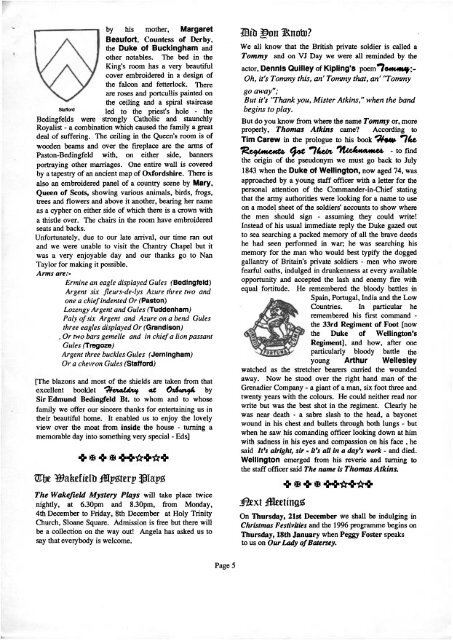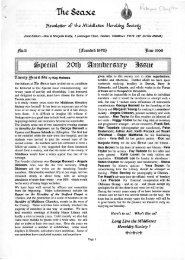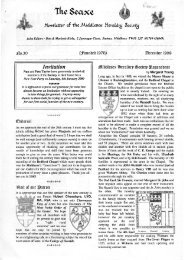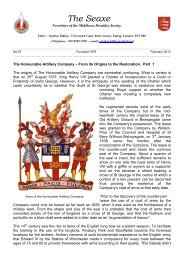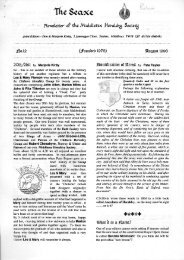The Seaxe - Middlesex Heraldry Society
The Seaxe - Middlesex Heraldry Society
The Seaxe - Middlesex Heraldry Society
Create successful ePaper yourself
Turn your PDF publications into a flip-book with our unique Google optimized e-Paper software.
y his mother, Margaret<br />
Beaufort, Countess of Derby,<br />
the Duke of Buckingham and<br />
other notables. <strong>The</strong> bed in the<br />
King's room has a very beautiful<br />
cover embroidered in a design of<br />
the falcon and fetterlock. <strong>The</strong>re<br />
are roses and portcullis painted on<br />
the ceiling and a spiral staircase<br />
Stafford led to the priest's hole - the<br />
Bedingfelds were strongly Catholic and staunchly<br />
Royalist - a combination which caused the family a great<br />
deal of suffering. <strong>The</strong> ceiling in the Queen's room is of<br />
wooden beams and over the fireplace are the arms of<br />
Paston-Bedingfeld with, on either side, banners<br />
portraying other marriages. One entire wall is covered<br />
by a tapestry of an ancient map of Oxfordshire. <strong>The</strong>re is<br />
also an embroidered panel of a country scene by Mary,<br />
Queen of Scots, showing various animals, birds, frogs,<br />
trees and flowers and above it another, bearing her name<br />
as a cypher on either side of which there is a crown with<br />
a thistle over. <strong>The</strong> chairs in the room have embroidered<br />
seats and backs.<br />
Unfortunately, due to our late arrival, our time ran out<br />
and we were unable to visit the Chantry Chapel but it<br />
was a very enjoyable day and our thanks go to Nan<br />
Taylor for making it possible.<br />
Arms are:-<br />
Ermine an eagle displayed Gules (Bedingfeld)<br />
Argent six fleurs-de-lys Azure three two and<br />
one a chief indented Or (Paston)<br />
Lozengy Argent and Gules (Tuddenham)<br />
Paly of six Argent and Azure on a bend Gules<br />
three eagles displayed Or (Grandison)<br />
Or two bars gemelle and in chief a lion passant<br />
Gules (Tregoze)<br />
Argent three buckles Gules (Jemingham)<br />
Or a chevron Gules (Stafford)<br />
[<strong>The</strong> blazons and most of the shields are taken from that<br />
excellent booklet <strong>Heraldry</strong> at Oxburgh by<br />
Sir Edmund Bedingfeld Bt. to whom and to whose<br />
family we offer our sincere thanks for entertaining us in<br />
their beautiful home. It enabled us to enjoy the lovely<br />
view over the moat from inside the house - turning a<br />
memorable day into something very special - Eds]<br />
<strong>The</strong> Wakefield Mystery Plays<br />
<strong>The</strong> Wakefield Mystery Plays will take place twice<br />
nightly, at 6.30pm and 8.30pm, from Monday,<br />
4th December to Friday, 8th December at Holy Trinity<br />
Church, Sloane Square. Admission is free but there will<br />
be a collection on the way out! Angela has asked us to<br />
say that everybody is welcome.<br />
Page 5<br />
Did You Know?<br />
We all know that the British private soldier is called a<br />
Tommy and on VJ Day we were all reminded by the<br />
actor, Dennis Quilley of Kipling's poem Tommy:-<br />
Oh, it's Tommy this, an' Tommy that, an' "Tommy<br />
go away";<br />
But it's "Thank you, Mister Atkins," when the band<br />
begins to play.<br />
But do you know from where the name Tommy or, more<br />
properly, Thomas Atkins came? According to<br />
Tim Carew in the prologue to his book How <strong>The</strong><br />
Regiments Got <strong>The</strong>ir Nicknames - to find<br />
the origin of the pseudonym we must go back to July<br />
1843 when the Duke of Wellington, now aged 74, was<br />
approached by a young staff officer with a letter for the<br />
personal attention of the Commander-in-Chief stating<br />
that the army authorities were looking for a name to use<br />
on a model sheet of the soldiers' accounts to show where<br />
the men should sign - assuming they could write!<br />
Instead of his usual immediate reply the Duke gazed out<br />
to sea searching a packed memory of all the brave deeds<br />
he had seen performed in war, he was searching his<br />
memory for the man who would best typify the dogged<br />
gallantry of Britain's private soldiers - men who swore<br />
fearful oaths, indulged in drunkenness at every available<br />
opportunity and accepted the lash and enemy fire with<br />
equal fortitude. He remembered the bloody battles in<br />
Spain, Portugal, India and the Low<br />
Countries. In particular he<br />
remembered his first command -<br />
the 33rd Regiment of Foot [now<br />
the Duke of Wellington's<br />
Regiment], and how, after one<br />
particularly bloody battle the<br />
young Arthur Wellesley<br />
watched as the stretcher bearers carried the wounded<br />
away. Now he stood over the right hand man of the<br />
Grenadier Company - a giant of a man, six foot three and<br />
twenty years with the colours. He could neither read nor<br />
write but was the best shot in the regiment. Clearly he<br />
was near death - a sabre slash to the head, a bayonet<br />
wound in his chest and bullets through both lungs - but<br />
when he saw his commanding officer looking down at him<br />
with sadness in his eyes and compassion on his face, he<br />
said It's alright, sir - it's all in a day's work - and died.<br />
Wellington emerged from his reverie and turning to<br />
the staff officer said <strong>The</strong> name is Thomas Atkins.<br />
Next Meetings<br />
On Thursday, 21st December we shall be indulging in<br />
Christmas Festivities and the 1996 programme begins on<br />
Thursday, 18th January when Peggy Foster speaks<br />
to us on Our Lady of Batersey.


